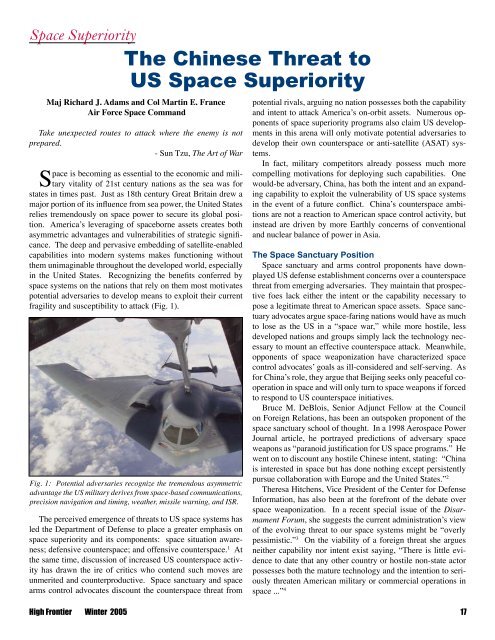Space Superiority
Space Superiority
Space Superiority
You also want an ePaper? Increase the reach of your titles
YUMPU automatically turns print PDFs into web optimized ePapers that Google loves.
<strong>Space</strong> <strong>Superiority</strong><br />
The Chinese Threat to<br />
US <strong>Space</strong> <strong>Superiority</strong><br />
Maj Richard J. Adams and Col Martin E. France<br />
Air Force <strong>Space</strong> Command<br />
Take unexpected routes to attack where the enemy is not<br />
prepared.<br />
- Sun Tzu, The Art of War<br />
<strong>Space</strong> is becoming as essential to the economic and military<br />
vitality of 21st century nations as the sea was for<br />
states in times past. Just as 18th century Great Britain drew a<br />
major portion of its influence from sea power, the United States<br />
relies tremendously on space power to secure its global position.<br />
America’s leveraging of spaceborne assets creates both<br />
asymmetric advantages and vulnerabilities of strategic significance.<br />
The deep and pervasive embedding of satellite-enabled<br />
capabilities into modern systems makes functioning without<br />
them unimaginable throughout the developed world, especially<br />
in the United States. Recognizing the benefits conferred by<br />
space systems on the nations that rely on them most motivates<br />
potential adversaries to develop means to exploit their current<br />
fragility and susceptibility to attack (Fig. 1).<br />
Fig. 1: Potential adversaries recognize the tremendous asymmetric<br />
advantage the US military derives from space-based communications,<br />
precision navigation and timing, weather, missile warning, and ISR.<br />
The perceived emergence of threats to US space systems has<br />
led the Department of Defense to place a greater emphasis on<br />
space superiority and its components: space situation awareness;<br />
defensive counterspace; and offensive counterspace. 1 At<br />
the same time, discussion of increased US counterspace activity<br />
has drawn the ire of critics who contend such moves are<br />
unmerited and counterproductive. <strong>Space</strong> sanctuary and space<br />
arms control advocates discount the counterspace threat from<br />
potential rivals, arguing no nation possesses both the capability<br />
and intent to attack America’s on-orbit assets. Numerous opponents<br />
of space superiority programs also claim US developments<br />
in this arena will only motivate potential adversaries to<br />
develop their own counterspace or anti-satellite (ASAT) systems.<br />
In fact, military competitors already possess much more<br />
compelling motivations for deploying such capabilities. One<br />
would-be adversary, China, has both the intent and an expanding<br />
capability to exploit the vulnerability of US space systems<br />
in the event of a future conflict. China’s counterspace ambitions<br />
are not a reaction to American space control activity, but<br />
instead are driven by more Earthly concerns of conventional<br />
and nuclear balance of power in Asia.<br />
The <strong>Space</strong> Sanctuary Position<br />
<strong>Space</strong> sanctuary and arms control proponents have downplayed<br />
US defense establishment concerns over a counterspace<br />
threat from emerging adversaries. They maintain that prospective<br />
foes lack either the intent or the capability necessary to<br />
pose a legitimate threat to American space assets. <strong>Space</strong> sanctuary<br />
advocates argue space-faring nations would have as much<br />
to lose as the US in a “space war,” while more hostile, less<br />
developed nations and groups simply lack the technology necessary<br />
to mount an effective counterspace attack. Meanwhile,<br />
opponents of space weaponization have characterized space<br />
control advocates’ goals as ill-considered and self-serving. As<br />
for China’s role, they argue that Beijing seeks only peaceful cooperation<br />
in space and will only turn to space weapons if forced<br />
to respond to US counterspace initiatives.<br />
Bruce M. DeBlois, Senior Adjunct Fellow at the Council<br />
on Foreign Relations, has been an outspoken proponent of the<br />
space sanctuary school of thought. In a 1998 Aerospace Power<br />
Journal article, he portrayed predictions of adversary space<br />
weapons as “paranoid justification for US space programs.” He<br />
went on to discount any hostile Chinese intent, stating: “China<br />
is interested in space but has done nothing except persistently<br />
pursue collaboration with Europe and the United States.” 2<br />
Theresa Hitchens, Vice President of the Center for Defense<br />
Information, has also been at the forefront of the debate over<br />
space weaponization. In a recent special issue of the Disarmament<br />
Forum, she suggests the current administration’s view<br />
of the evolving threat to our space systems might be “overly<br />
pessimistic.” 3 On the viability of a foreign threat she argues<br />
neither capability nor intent exist saying, “There is little evidence<br />
to date that any other country or hostile non-state actor<br />
possesses both the mature technology and the intention to seriously<br />
threaten American military or commercial operations in<br />
space ...” 4<br />
High Frontier Winter 2005 17

















